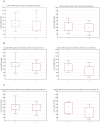Ectopic ACTH syndrome of different origin-Diagnostic approach and clinical outcome. Experience of one Clinical Centre
- PMID: 33237923
- PMCID: PMC7688153
- DOI: 10.1371/journal.pone.0242679
Ectopic ACTH syndrome of different origin-Diagnostic approach and clinical outcome. Experience of one Clinical Centre
Abstract
Purpose: Ectopic Cushing Syndrome (EAS) is a rare condition responsible for about 5-20% of all Cushing syndrome cases. It increases the mortality of affected patients thus finding and removal of the ACTH-producing source allows for curing or reduction of symptoms and serum cortisol levels. The aim of this study is to present a 20-year experience in the diagnosis and clinical course of patients with EAS in a single Clinical Centre in Southern Poland as well as a comparison of clinical course and outcomes depending on the source of ectopic ACTH production-especially neuroendocrine tumors with other neoplasms.
Methods: Twenty-four patients were involved in the clinical study with EAS diagnosed at the Department of Endocrinology between years 2000 and 2018. The diagnosis of EAS was based on the clinical presentation, hypercortisolemia with high ACTH levels, high dose dexamethasone suppression test and/or corticotropin-releasing hormone tests. To find the source of ACTH various imaging studies were performed.
Results: Half of the patients were diagnosed with neuroendocrine tumors, whereby muscle weakness was the leading symptom. Typical cushingoid appearance was seen in merely a few patients, and weight loss was more common than weight gain. Patients with neuroendocrine tumors had significantly higher midnight cortisol levels than the rest of the group. Among patients with infections, we observed a significantly higher concentrations of cortisol 2400 levels in gastroenteropancreatic neuroendocrine tumors. Chromogranin A correlated significantly with potassium in patients with neuroendocrine tumors and there was a significant correlation between ACTH level and severity of hypokalemia.
Conclusion: EAS is not common, but if it occurs it increases the mortality of patients; therefore, it should be taken into consideration in the case of coexistence of severe hypokalemia with hypertension and muscle weakness, especially when weight loss occurs. Because the diagnosis of gastroenteropancreatic neuroendocrine tumor worsens the prognosis-special attention should be paid to these patients.
Conflict of interest statement
The authors have declared that no competing interests exist.
Figures



Similar articles
-
ECTOPIC CUSHING SYNDROME: A 10-YEAR EXPERIENCE FROM A TERTIARY CARE CENTER IN SOUTHERN INDIA.Endocr Pract. 2017 Aug;23(8):907-914. doi: 10.4158/EP161677.OR. Epub 2017 Jun 14. Endocr Pract. 2017. PMID: 28614007
-
Human corticotropin releasing hormone test performance in the differential diagnosis between Cushing's disease and pseudo-Cushing state is enhanced by combined ACTH and cortisol analysis.Eur J Endocrinol. 2009 Jun;160(6):891-8. doi: 10.1530/EJE-09-0125. Epub 2009 Mar 25. Eur J Endocrinol. 2009. PMID: 19321661
-
Clinical features and management of ectopic ACTH syndrome at a single institute in Japan.Endocr J. 2010;57(12):1061-9. doi: 10.1507/endocrj.k10e-265. Epub 2010 Nov 9. Endocr J. 2010. PMID: 21076235
-
Appendiceal Neuroendocrine Tumor Is a Rare Cause of Ectopic Adrenocorticotropic Hormone Syndrome With Cyclic Hypercortisolism: A Case Report and Literature Review.Front Endocrinol (Lausanne). 2022 Feb 18;13:808199. doi: 10.3389/fendo.2022.808199. eCollection 2022. Front Endocrinol (Lausanne). 2022. PMID: 35250866 Free PMC article. Review.
-
Localization diagnosis of adrenocorticotrophic hormone-dependent Cushing's syndrome: two case reports and literature review.Ann Palliat Med. 2022 Dec;11(12):3804-3817. doi: 10.21037/apm-22-1177. Ann Palliat Med. 2022. PMID: 36636004 Review.
Cited by
-
Catastrophic ACTH-secreting pheochromocytoma: an uncommon and challenging entity with multifaceted presentation.Endocrinol Diabetes Metab Case Rep. 2023 May 2;2023(2):22-0308. doi: 10.1530/EDM-22-0308. Print 2023 May 1. Endocrinol Diabetes Metab Case Rep. 2023. PMID: 37162230 Free PMC article.
-
A Cadaveric Case of Bilateral Adrenal Hyperplasia With Lung Cancer: A Paraneoplastic Syndrome?Cureus. 2024 May 1;16(5):e59443. doi: 10.7759/cureus.59443. eCollection 2024 May. Cureus. 2024. PMID: 38826887 Free PMC article.
-
Advances in multimodal imaging for adrenal gland disorders: integrating CT, MRI, and nuclear medicine.Jpn J Radiol. 2025 Jun;43(6):903-926. doi: 10.1007/s11604-025-01732-6. Epub 2025 Jan 11. Jpn J Radiol. 2025. PMID: 39794659 Free PMC article. Review.
-
A Case of Pancreatic Neuroendocrine Tumor with Liver Metastases Demonstrating the Possibility of Enhanced ACTH Production by the SACI Test.Case Rep Endocrinol. 2024 Apr 20;2024:5923680. doi: 10.1155/2024/5923680. eCollection 2024. Case Rep Endocrinol. 2024. PMID: 38681235 Free PMC article.
-
Management of adrenocorticotropic hormone-secreting neuroendocrine tumors and the role of bilateral adrenalectomy in ectopic Cushing syndrome.Surgery. 2022 Aug;172(2):559-566. doi: 10.1016/j.surg.2022.03.014. Epub 2022 Apr 16. Surgery. 2022. PMID: 35437162 Free PMC article.
References
-
- Cieszyński Ł, Obołończyk MB, Szulc M, Sworczak K. Zespół Cushinga w przebiegu ektopowego wydzielania ACTH. Endokrynol Pol. 2015. October 29;64(6):480–93.
-
- Lacroix A, Feelders RA, Stratakis CA, Nieman LK. Cushing’s syndrome. Lancet (London, England). 2015. August 29;386(9996):913–27. - PubMed
Publication types
MeSH terms
Substances
LinkOut - more resources
Full Text Sources
Research Materials

